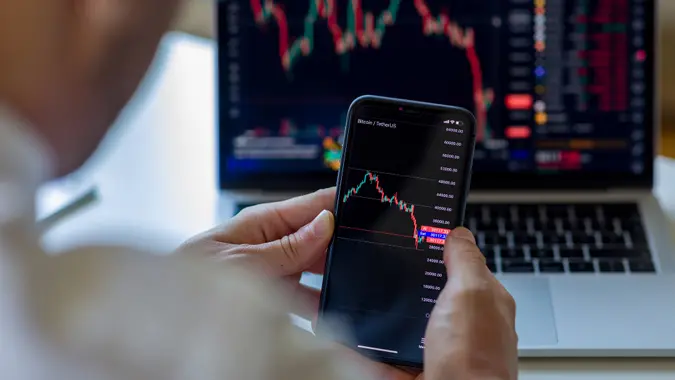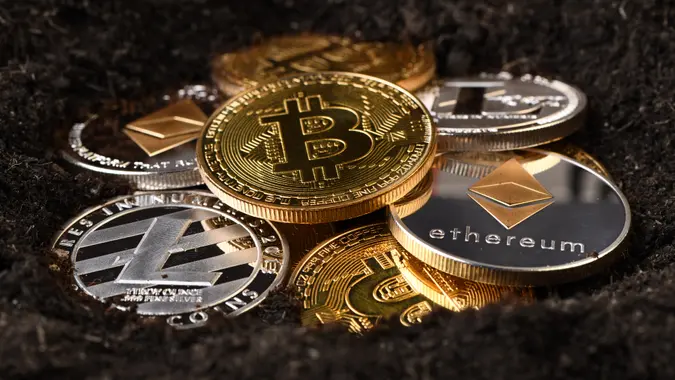Coinbase vs. Binance: Which Cryptocurrency Exchange Is Better?

Commitment to Our Readers
GOBankingRates' editorial team is committed to bringing you unbiased reviews and information. We use data-driven methodologies to evaluate financial products and services - our reviews and ratings are not influenced by advertisers. You can read more about our editorial guidelines and our products and services review methodology.

20 Years
Helping You Live Richer

Reviewed
by Experts

Trusted by
Millions of Readers
Cryptocurrency exchanges are online platforms where cryptocurrencies are traded for other digital assets and fiat currencies. There are centralized and decentralized exchanges used for buying and selling crypto assets.
Two of the top centralized exchanges, based on trading volumes, liquidity, and amount of traffic, are Coinbase and Binance. Both have strengths and weaknesses, and one may be more appropriate for yo,u depending on what type of crypto trader or investor you are. It may also matter if you are a domestic-based or international trader. Here’s an overview of the most important things you’ll need to know about both Coinbase and Binance to help you determine which one is a better match for your investment profile.
Supported Cryptocurrencies
An important factor in choosing the right exchange is whether or not a platform offers the cryptocurrencies that you are interested in trading. Here’s how the two competitors stack up.
Binance
- Offers more than 500 cryptos and altcoins: Binance currently offers a more extensive range of trading options.
- High availability of altcoins and new projects: Binance aims for quantity when it comes to its offerings for clients, specializing in providing a large number of altcoin choices for traders and investors.
Coinbase
- Uses a more precise approach to investing: While still offering hundreds of options, Coinbase has a much more limited product line than Binance.
- Focuses on the most popular and stable coins: Coinbase primarily offers access to the most well-known cryptos, such as Bitcoin and Ethereum, that dominate the market in terms of size.
What’s important to note in this comparison, however, is that Binance.US, the offshoot of Binance created to comply with U.S. regulatory requirements, offers only about 150 coins and tokens–fewer than Coinbase.
Fees and Pricing Structure
As with any investment, fees and expenses can eat into your crypto returns. Here are the major costs associated with using Binance and Coinbase.
Coinbase
Coinbase determines its trading fees using a maker-taker fee model. Fees are calculated when orders are placed and not on after-trade completion tiers.
An order placed at market price is filled immediately and requires a taker fee between 0.05% and 0.60%. An order that is not immediately matched with an existing order is placed on the order book. If an order is placed that matches that order, the matched order is considered the maker order and incurs a fee between 0.00% and 0.40%.
Sending and receiving cryptocurrency is free for merchants, friends, and other Coinbase users. However, customers will be responsible for miner fees on external crypto transactions. Miner fees, also called mining or network fees, are paid to cryptocurrency mining systems that securely process transactions over cryptocurrency networks. These fees can vary but will be disclosed at the time of your transaction.
Coinbase vs. Coinbase Advanced Trade
Coinbase and Coinbase Advanced Trade, formerly Coinbase Pro, both carry a variety of crypto assets and have similar features. The biggest difference between the two exchange platforms is that Coinbase Advanced Trade is better suited for advanced traders looking for better trading capabilities and features. It can also cost a lot less for active traders, as the fee — which can go as low as 0.0% — is based on trading volume for the prior 30 days. The standard version of Coinbase would appeal more to basic traders needing a more straightforward trading platform.
Coinbase doesn’t charge a fee for ACH withdrawals in U.S. dollars, but fees for withdrawing specific cryptocurrencies may vary.
Binance
Binance uses a tiered fee system based on your trading volume for the prior 30 days. Spot and margin maker fees range from 0.011% to 0.10%, while taker fees run from 0.023% to 0.10%. You can get a 25% discount on your fees if you use the Binance Coin (BNB) token, dropping costs even further.
Binance.US offers free Bitcoin trading on select pairs, including 0% fees on Tier 0 pairs. Binance.US also offers a 5% discount on Advanced Trading (Spot Trading) when you pay with BNB.
Withdrawal rates from Binance vary depending on the currency used. Some withdrawal fees are as low as $0.
Payment Methods and Deposit Options
Most crypto investors want flexibility in deposit and withdrawal options. Here’s what each major exchange offers.
Binance
Binance offers a wide variety of deposit options. Users can deposit funds via crypto, bank account, Binance P2P, or the purchase of crypto with cash.
You can withdraw money from Binance in cryptocurrency or fiat currency, such as the U.S. dollar.
Note that the availability of local payment methods may vary depending on your region.
Coinbase
You can deposit cash to your Coinbase account via FAST/PayNow or USD SWIFT. You can also deposit funds via wire transfer, Interac, PIX, bank transfers, and debit/credit cards. You can also make cryptocurrency deposits. Note that some deposit (and withdrawal) methods will vary by country. Unlike Binance, Coinbase does not allow P2P deposits.
For withdrawals, Coinbase offers instant cashouts from a Coinbase balance to a verified payment method. Cryptocurrency can also be transferred out.
Overall, both Coinbase and Binance offer plenty of ways for customers to make deposits and withdrawals. However, Binance offers more P2P options.
User Interface and Experience
The best trading platform in the world is useless unless users can experience and enjoy it. Here’s how the two exchanges stack up.
Binance
Binance offers advanced charting and trading options, which can make it a good option for serious crypto traders. However, this also makes the user interface much more complex. Those simply looking to pick up some Bitcoin or Ethereum might find it overwhelming.
Coinbase
Coinbase offers a relatively simple, intuitive interface designed for beginners. Its easy-to-navigate app and website are more accessible for casual users who are just dabbling in their first cryptocurrencies or for those who don’t need advanced trading tools.
Security Features and Protocols
Security is critical when it comes to a cryptocurrency exchange, as digital assets are like honey for hackers and can be hard to trace or recover if they are stolen. Here’s how the two exchanges compare in terms of security protocols.
Binance
- Two-factor authentication (2FA)
- Cold Wallet Storage
- Insurance Fund
- Past Security Breach
Two-factor authentication uses hardware, mobile apps, SMS and email methods to ensure customer verification. Cold wallets store private keys offline, helping protect them from hackers.
Binance has an insurance fund for customer accounts known as the SAFU, or Secure Asset Fund for Users. It was established in 2018 and consists of 1 billion USDC.
It’s important to note, however, that Binance has suffered from a major security breach in the past. On May 7, 2019, Binance announced that hackers were able to withdraw 7,000 Bitcoin, which amounted to about 2% of Binance’s entire Bitcoin portfolio at the time. In 2022, the Binance network was hacked again, this time for $570 million, according to Levin Law.
Coinbase
- Two-factor authentication (2FA)
- Cold Wallet Storage
- Insurance Fund
- No Major Breaches Reported
While the general safety and security protocols offered by Binance and Coinbase are similar, Coinbase has never suffered a hack, while Binance has suffered at least two major incidents. This has contributed to Coinbase’s strong reputation for protecting user funds.
Coinbase does not have a separate insurance fund for its customer accounts, but to the extent funds are held in U.S. dollars as cash, they enjoy FDIC protection of up to $250,000 per depositor, as with any regulated U.S. bank.
Mobile App Features and Usability
In the digital world, a good mobile app is critical for trading assets and moving money. Here are the differences between Binance and Coinbase in terms of mobile access.
Binance
The entire Binance universe is geared towards more active and sophisticated traders who want access to a wide variety of crypto options. Its mobile app reflects this, with advanced trading tools, charts, alerts, and other features that appeal to traders more than beginners. Overall, the mobile app interface is more complex than Coinbase’s, which can be good or bad depending on what type of investor you are.
Coinbase
Coinbase, on the other hand, tries to make crypto investing simple. Its mobile app interface is simple and easy to use, and it isn’t cluttered with advanced features that most beginning crypto investors don’t need. Buy and sell options are easy to find and use, making it a good platform for those interested in cryptos like Bitcoin and Ethereum only.
Pros and Cons of Binance and Coinbase
All investment trading platforms have pros and cons. Here’s a look at Binance and Coinbase’s highlights and drawbacks.
Binance Pros
- Lower fees
- Large selection of cryptocurrencies
- Advanced features
Binance Cons
- More complex for beginners
- Regulatory challenges in some countries (including the United States)
Coinbase Pros
- Easy to use
- Trusted platform
- Strong educational resources
Coinbase Cons
- Higher fees
- Limited cryptocurrency selection
Kelli Francis contributed to the reporting for this article.
Data is accurate as of Feb. 17, 2025, and is subject to change.
Editorial Note: This content is not provided by any entity covered in this article. Any opinions, analyses, reviews, ratings or recommendations expressed in this article are those of the author alone and have not been reviewed, approved or otherwise endorsed by any entity named in this article.
Our in-house research team and on-site financial experts work together to create content that’s accurate, impartial, and up to date. We fact-check every single statistic, quote and fact using trusted primary resources to make sure the information we provide is correct. You can learn more about GOBankingRates’ processes and standards in our editorial policy.
- Forbes. 2023. "Binance.US Review 2023."
- Forbes. 2023. "Binance vs. Coinbase: Which Crypto Exchange Is Right For You?"
- Business Insider. 2022. "Coinbase vs. Coinbase Pro: How to choose between the basic and advanced crypto accounts."
- Fortune. 2022. "Can you buy crypto with a credit card? Yes, but it might cost you in fees and interest."
- Forbes. 2022. "Coinbase Review 2023."
- Bitstamp Learn. 2022. "How does a crypto exchange work?"
- CFI. 2023. "Cryptocurrency Exchanges."
- CFI. 2023. "Hot Wallet."
- CoinMarketCap. "Top Cryptocurrency Spot Exchanges."
 Written by
Written by  Edited by
Edited by 

























